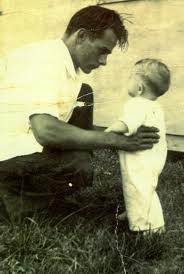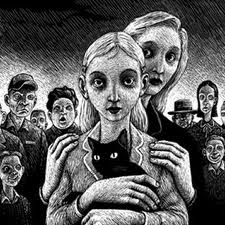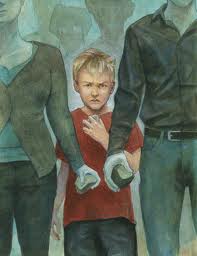Losing your mind: What happens during 48 hours in a pitch black bunker
by NATASHA COURTENAY-SMITH

Not a laughing matter: Comedian Adam Bloom had hallucinations during the experiment
You are in a small underground chamber, no bigger than a prison cell. The door is locked and the lights are switched out.
It is not just dark; it’s pitch black.
In these conditions, it would be impossible to see even the faintest hint of your hand were it inches from your eyes. And the silence is all-encompassing.
The only noise you can hear is the sound of your own breathing . . . in and out, in and out.
The sense of isolation is not just eerie, it’s as if you had been cast into the furthest reaches of space, or into the deepest subterranean cavern.
Now imagine staying in these conditions for hours on end. With no way to tell whether it was night or day, would you pass the time asleep?
Or, if awake, how would you stay alert in the absence of a single sight, sound or stimulus?
Could any human, in fact, endure such total sensory deprivation without losing their sanity?
That was what British scientists sought to discover in one of the most extreme and controversial experiments to be conducted on the human mind.
They put a group of six volunteers into a total isolation chamber, constructed in a former nuclear bunker in Hertfordshire, to monitor the effects it would have on their mind and physical health over 48 hours.
The results, to be shown on a BBC2 documentary tonight, are intriguing. But this was not just a reality show stunt.
The researchers involved hoped to shed new light on the validity of statements given by terror suspects who have been held in extreme conditions in camps such as Guantanamo Bay.
“It is important to look at the impact of sensory deprivation because of the number of places around the world where it is used as a weapon or to aid interrogation,” says Professor Steven Robbins, who oversaw the experiments and is one of the Britain’s leading experts on the effects of psychological torture.
“We know that stimulating the brain helps increase connections in the brain that speeds up information processing, but we wanted to find out if the reverse occurs.”
The risks were considerable. Similar experiments carried out in the Fifties by Canadian psychologist Professor Donald Hebb had to be abandoned after volunteers were unable to endure the conditions for more than 48 hours.

Monitored: CCTV shows each isolation room in the bunker
One subject described the sensory deprivation as being “as bad as anything Hitler had ever done to any of his victims”.
Afterwards, Hebb reported that the “very identity” of his subjects had begun to disintegrate within two days.
That is why sensory deprivation is still used as a means of extracting information from prisoners, though human rights campaigners claim it is inhumane and an unreliable technique.
So, who would be brave, or foolish, enough to undergo a similar ordeal voluntarily?
Step forward comedian Adam Bloom, 37, one of the six human guinea pigs who agreed to undergo solitary confinement in the bunker, and have the effects on his brain monitored for the TV documentary.
For two days and two nights, he sat in total darkness and silence, while the researchers were able to observe his behaviour using night-vision cameras. As with real-life prisoners of war, his only comfort was an occasional meal brought to him by his “captors”.
“I’m a very busy person, with a mind that is always racing with thoughts and ideas,” says Bloom.
“My job involves coming up with new jokes all the time and I work by constantly observing my surroundings for anything that I could use on stage.
“I reckoned 48 hours wasn’t that long and I was sure I could cope.”
So what happened when the door was slammed shut?
“I spent the first half an hour in the bunker talking, singing and making jokes, but that quickly got boring. So, I took to sitting on my bed, staring in front of me.
“My mind filled up with thoughts of my life outside, and I started to worry about my fiancÈe and family. What if something happened to them while I’m in here? Would anyone let me know? It didn’t take me long to feel more anxious that I usually would.”

Gruelling: Volunteers spent two days in total isolation to monitor effects on their mind
Within a few hours of entering the bunker, Bloom fell asleep. But when he woke up, he realised that coping with sensory deprivation was going to be far tougher than he’d imagined.
“In the absence of a watch or sunlight, I’d totally lost track of time,” he says. “I dozed on and off for what I thought was a few hours, but when I woke up I had no idea whether it was day or night. It was really unnerving.
“Even eating the meals I was handed didn’t help me reset my body clock. I felt horrendously bored, and completely out of touch with everything.”
Eighteen hours into the experiment, Bloom began to get increasingly paranoid.
“At one point, I started singing and then I burst into tears,” he says. “I can’t remember the last time I cried, and I felt my emotions were beginning to run out of control.”
“Then, I found myself suspecting the whole experiment was a trick. How did I know who these people really were? What if they’d gone home and I was trapped down there for ever?
“I knew I was being ridiculous, because setting up the experiment had taken months and involved lengthy meetings and e-mails, but I couldn’t shake the sense of paranoia.”
By the time he had been in the bunker for 24 hours, Bloom’s mental alertness was slowing down.
“Without light, it was almost impossible to stimulate myself and my brain felt as though it was going to sleep,” he says.
But his real troubles came 30 hours into the experiment. By then, he had taken to pacing the room endlessly in a bid to keep himself occupied.
“This behaviour is often seen in animals, as well as people, when they are kept in confinement,” says Professor Robbins. “It’s a way of providing input into your life physically.”

Isolation: Time spent in the bunker reduced memory, ability to process information and increased suggestibility
But after 40 hours, events took a more sinister turn. Bloom began to hallucinate: he saw a pile of 500 oyster shells. “I could see the pearly sheen on the oyster shells as clear as day,” he says.
Bloom says: “Then I felt as though the room was taking off from underneath me. For the first time, I realised that the lack of stimulation was driving me close to insanity.
“I felt nothing but numbness, as though I was losing the will to live.
“I considered pulling out, but I told myself that at least I could comfort myself with the thought that my ordeal was soon going to be over. Some prisoners have had to endure these conditions for months, or even years.”
Bloom was released after 48 hours to undergo psychological tests. The results were compared with identical tests he had carried out before his incarceration, and showed a clear impairment of his ability to process information, a reduction in memory and an increase in suggestibility.
How people’s brains are affected by a short spell of isolation is not fully understood, but Professor Robbins believes that dendrites – which connect nerve cells and help them to communicate – may lose some of their efficacy if not continually stimulated.
But for Bloom, there was an unexpected outcome. “When we’d arrived at the bunker before the experiment, I had thought it was all rather bleak,” he says.
“The exterior was all overgrown and the bunker was an eyesore. But when I left after 48 hours, I noticed how green the grass was, how blue the sky was and hundreds of yellow buttercups.
“It was staggeringly beautiful. Even washing my hands under the tap was amazing.
“I made a vow that I would never not notice and appreciate my surroundings again.
“I’m glad I did it, but no sum of money would convince me to go through 48 hours on my own again. It was the greatest endurance test of my life.”
 So. Have you noticed I’m repetitive? Well, I am. Today I started every class by making every student face the wall and stare at the dark green border running along it. And what was on that dark green border? Thumb tacks. Thumb tacks that were placed exactly 17 spaces after the previous thumb tack. What was the purpose of this exercise? To remind you that a person who would take the time to place dumb old thumb tacks exactly 17 spaces apart would also be nit picky enough to notice if you didn’t write using capital letters or didn’t answer every question on the assignment sheet or didn’t use quotes in the paragraph. I am that nit picky Thumb Tack Queen and I notice things.
So. Have you noticed I’m repetitive? Well, I am. Today I started every class by making every student face the wall and stare at the dark green border running along it. And what was on that dark green border? Thumb tacks. Thumb tacks that were placed exactly 17 spaces after the previous thumb tack. What was the purpose of this exercise? To remind you that a person who would take the time to place dumb old thumb tacks exactly 17 spaces apart would also be nit picky enough to notice if you didn’t write using capital letters or didn’t answer every question on the assignment sheet or didn’t use quotes in the paragraph. I am that nit picky Thumb Tack Queen and I notice things. UPDATE: File this under the categories of Delayed Reaction and/or Watson Still Having Trouble with Math. Exactly three weeks after this post, I look up to see two of you patiently counting the spaces between thumbtacks. Apparently I have inadvertently lied to you because a) my thumbtack memory isn’t working and b) it didn’t occur to me to recount. There are not 17 spaces between the thumbtacks. There are 38. I stand and sit corrected. I am very flattered that I have my own personal fact checkers. So do Barack Obama and Mitt Romney.
UPDATE: File this under the categories of Delayed Reaction and/or Watson Still Having Trouble with Math. Exactly three weeks after this post, I look up to see two of you patiently counting the spaces between thumbtacks. Apparently I have inadvertently lied to you because a) my thumbtack memory isn’t working and b) it didn’t occur to me to recount. There are not 17 spaces between the thumbtacks. There are 38. I stand and sit corrected. I am very flattered that I have my own personal fact checkers. So do Barack Obama and Mitt Romney.











 Monitored: CCTV shows each isolation room in the bunker
Monitored: CCTV shows each isolation room in the bunker Gruelling: Volunteers spent two days in total isolation to monitor effects on their mind
Gruelling: Volunteers spent two days in total isolation to monitor effects on their mind Isolation: Time spent in the bunker reduced memory, ability to process information and increased suggestibility
Isolation: Time spent in the bunker reduced memory, ability to process information and increased suggestibility












